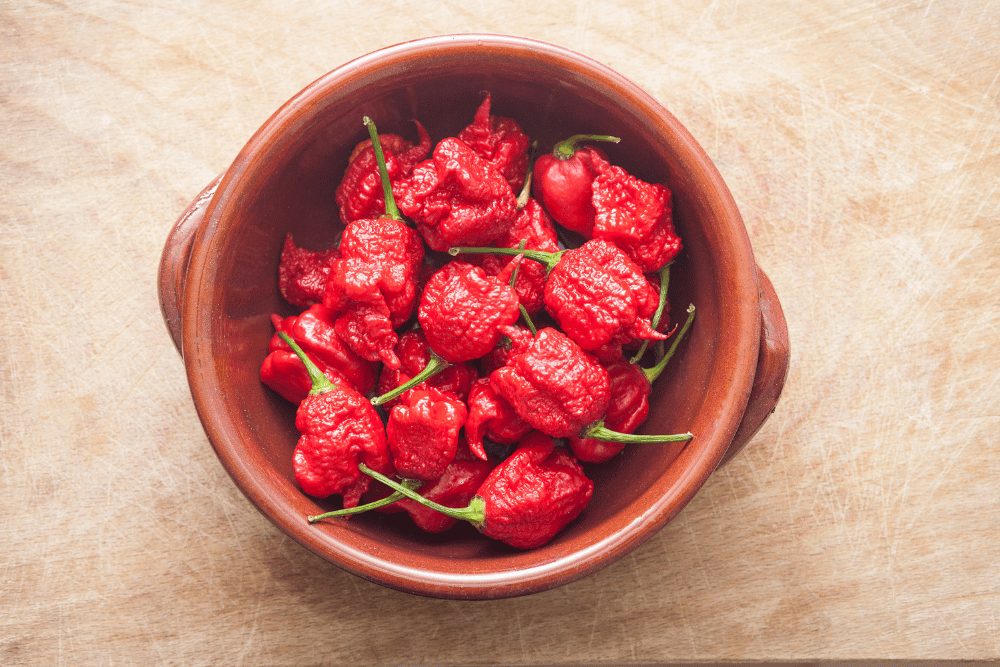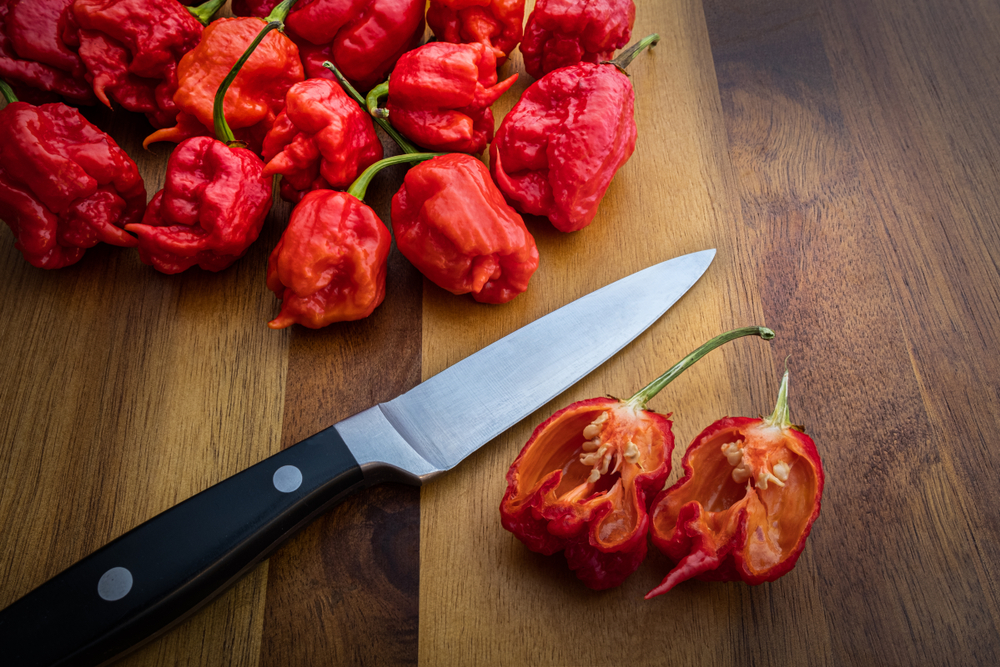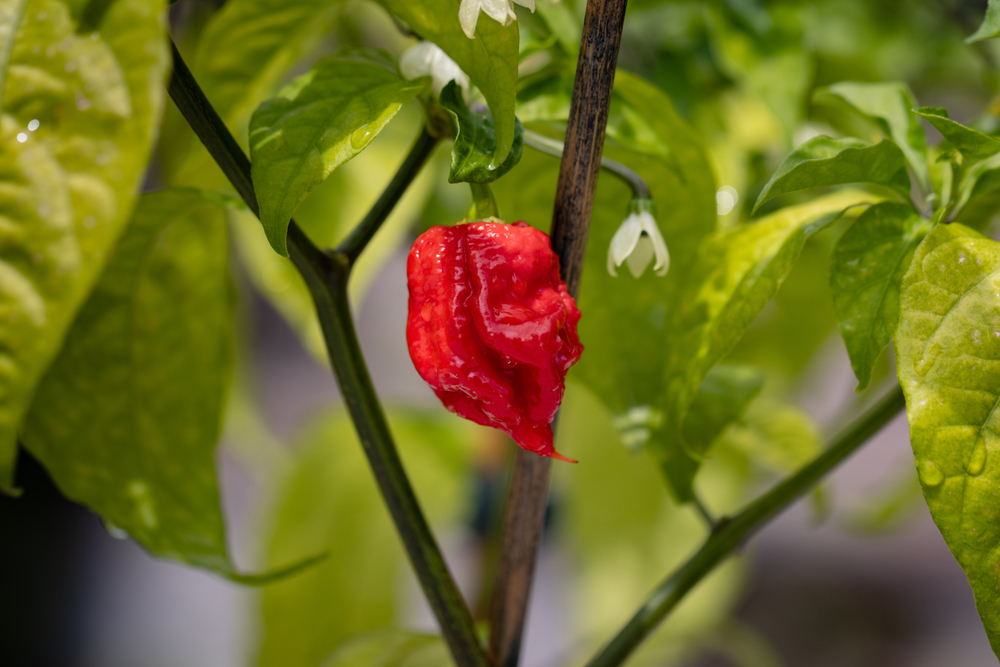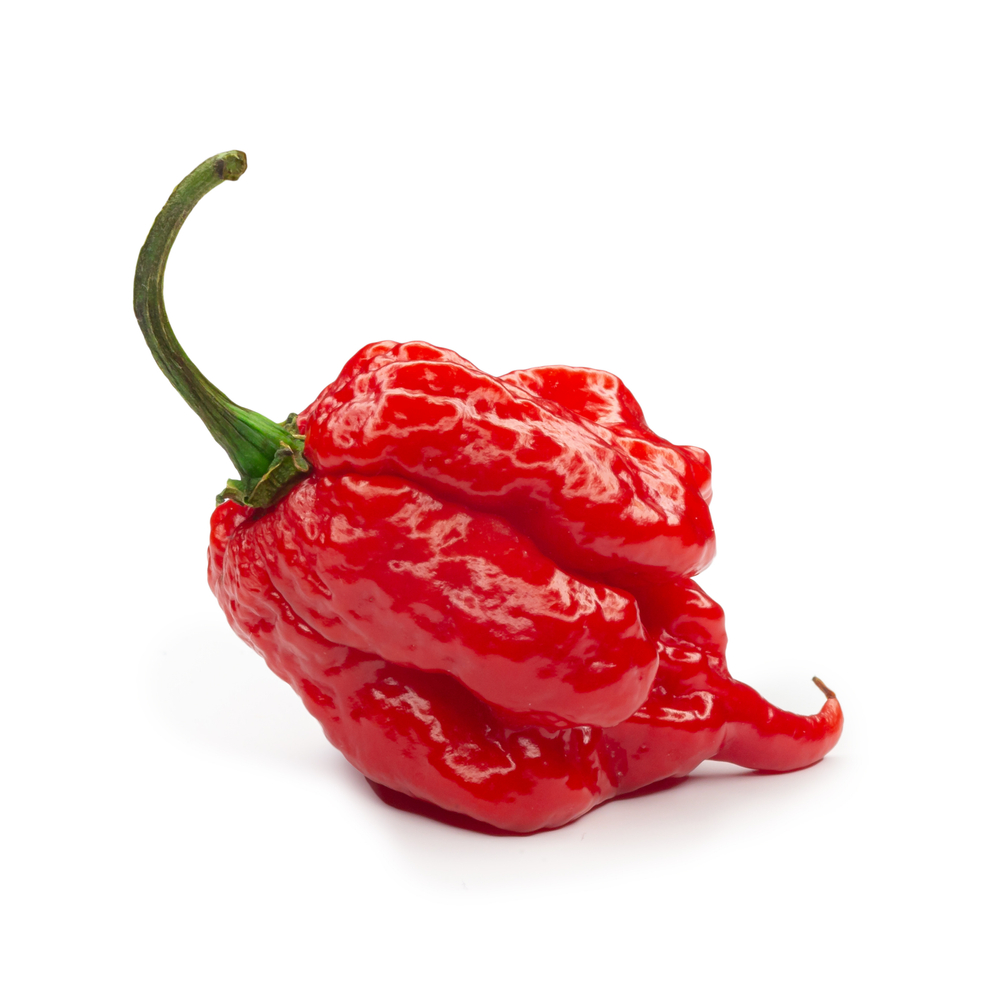Carolina reaper is the current king of peppers, proudly wearing the crown for the world's hottest pepper. Its wrinkled, red appearance and scorpion-like tail even look mean. But despite its extreme heat, the Carolina reaper has become a culinary favorite and a common ingredient in hot sauces and other fiery favorites.
What Are Carolina Reaper Peppers?
The Carolina reaper was developed and cultivated in South Carolina by Ed Currie, grower and founder of the Puckerbutt Pepper Company. It’s a scorching cultivar of Capsicum chinense, and the current Guinness World Record holder for the hottest pepper.
By crossbreeding a Pakistani naga pepper with a La Soufriere pepper— a rare habanero grown on the slopes of a volcano on the island of St. Vincent—he successfully created the hottest pepper the world has seen. The capsaicin level (the chemical responsible for the heat level in a pepper) was tested and certified by Winthrop University at a blistering 2.2 million SHU (Scoville heat unit).
Carolina Reaper Quick Facts
Origin: South Carolina
Color: Red
Flavor: Fruity
Size: 1-2 inches
Other Names: Originally referred to as HP22B, the name was later changed to Carolina reaper, which refers to its origin and appearance.

How Spicy Are Carolina Reapers?
Carolina reaper currently tops the list of superhot peppers with an average rating on the Scoville scale of 1,641,183 SHUs. Some have measured as high as 2.2 million SHU, though.
If saying it’s the hottest pepper in the world doesn’t provide a clear enough picture, the following chart shows how the Carolina reaper compares to other scorching peppers and some of the more commonly used chilis.
- Carolina reaper pepper, 1,400,000 – 2,200,000 SHUs
- Trinidad Moruga scorpion pepper, 1,550,000- 2,009,000 SHUs
- Ghost pepper (bhut jolokia), 800,000 – 1,000,000 SHUs
- Red savina habanero pepper, 350,000-577,000 SHUs
- Serrano pepper, 10,000 – 20,000 SHUs
- Jalapeno pepper, 2,500 – 8,000 SHUs
Are Carolina Reaper Peppers The Hottest In The World?
Carolina reapers consistently measure higher on the Scoville scale than any other hot pepper. The word to notice in that sentence is “consistently.”
Determining the rankings for the world’s hottest peppers requires measuring many peppers of each cultivar. Occasionally, individual peppers of other cultivars will measure hotter than the average Carolina reaper, but these are one-offs. The consistency within the reaper’s measurements has allowed it to maintain the hottest chili pepper crown.
Among the other pepper varieties that have occasionally gone beyond the reaper in heat are:
- Komodo dragon pepper
- Trinidad Moruga scorpion pepper
- 7-pot douglah
There are two footnotes to the reaper’s ranking: the dragon’s breath pepper and pepper X.
The dragon’s breath pepper measures 2.5 million SHUs – far hotter than the Carolina reaper and its cronies. But the dragon’s breath pepper is considered inedible and was cultivated for medical use rather than culinary use. So, while it’s clearly the hottest pepper known, it doesn’t fall into a comparable category for the official title.
Pepper X was created and cultivated by Ed Currie, the same grower responsible for the Carolina reaper.
Although unverified at the moment, it’s said that pepper X can measure as high as 3.5 million SHU. This level of heat would be wholly inedible and quite dangerous.
What is the world record for eating the most Carolina Reapers?
Despite its extreme heat, lovers of spicy foods routinely add Carolina reapers to certain dishes. Most, however, don’t eat them raw.
Most don’t – but some do.
Daredevil heat lover Greg Foster set the record for most Carolina Reapers eaten on September 17, 2022.
Foster ate 10 Carolina reapers in 33.15 seconds, beating his record from 2021 and earning him a spot in the Guinness Book Of World records.
What does eating a Carolina Reaper do to your body?
Thinking of challenging Foster and his record? Before you do, consider what eating a Carolina reaper can do to your body.
The most apparent effects of eating wildly hot peppers are:
- An inconsolable sensation of heat and burning in your mouth and throat.
- Severe stomach upset and possible vomiting.
- Intestinal upset and diarrhea.
But there are also more severe complications that can occur as well. Some dangerous repercussions of extreme heat eating include:
- Sudden respiratory problems
- Heart attack
- “Thunderclap” headaches that can foretell stroke as a result of sudden constriction of arteries in the brain.
In short, there’s nothing pleasant about eating a whole Carolina reaper.
How To Use Carolina Reaper Peppers
If you like heat and want to include the reaper in your culinary adventures, doing so in small doses and combined with other ingredients is the best.
Carolina reapers can be used to create potent hot sauces or salsas. Or add it to any recipe that calls for spicy peppers. Some of the most common uses include:
- Hot sauces
- Marinades
- Sauces
- Soups
- Rubs
- A seasoning for jerky
It can also be dried and ground into Carolina reaper powder for seasoning.
If you are going to cook with Carolina reaper (or any other extreme pepper), it’s essential to do so in a safe manner.
The capsaicin concentration in the Carolina reaper can cause chemical burns to the skin, and the fumes from the oil within the pepper can cause eye and respiratory irritation. Proper precautions should be taken when handling these peppers. These include,
- Gloves
- Kitchen goggles
- Nose/mouse mask
- Thorough cleaning of any area or utensil touched by the peppers.

Where To Buy Carolina Reapers
The Carolina reaper’s popularity has helped make it easier to find. Most grocery stores now carry a small number of fresh peppers in the produce section.
And many products using Carolina reapers can also be found on store shelves. Anything from bottled hot sauce to barbeque sauce has super hot versions incorporating the reaper.
Can You Grow Carolina Reapers?
If you can’t find the Carolina reaper at your local grocer, you can always grow your own.

Growing Carolina reaper plants is relatively easy. Most nurseries carry a few reapers alongside the many other pepper plants.
Carolina reaper seeds can also be found in most nurseries or ordered online from any number of retailers.
Pepper seeds should be started indoors approximately 8 weeks before the last frost. Keep them in a warm and sunny location, using a heat mat if needed. Germination typically occurs within 7-14 days.
Once 4-6 leaves are present, the plants can be transplanted outdoors directly into your garden or containers.
Like all pepper plants, Carolina reapers prefer warm temperatures and direct sun for most of the day. The soil should be loamy and well-draining.
Substitutes For Carolina Reaper Peppers
Proper substitutes for the Carolina reaper’s heat can be hard to find.
Peppers with similar heat levels include:
- Trinidad Moruga Scorpion
- 7-pot peppers (there are several varieties)
These make the best choices, but they are rare in grocery stores.
If it’s a matter of flavor, habaneros are the best choice. They will provide a similar flavor profile but far less heat, so you’ll need to adjust your recipe to use more habaneros.

